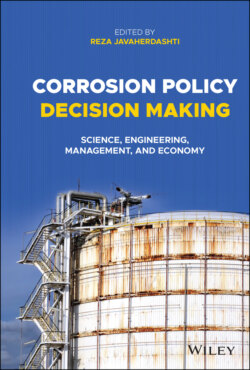Читать книгу Corrosion Policy Decision Making - Группа авторов - Страница 18
2.1.2.2 Galvanic Series
ОглавлениеDue to limitations of hydrogen electrode measurement for constructing electrochemical series, another option has been applied which is called “electrochemical series.” The potentials used in a galvanic series are only valid in:
1 a given environment (electrolyte), and
2 at a given temperature (25 °C).
Temperatures can be corrected for any given environment, but the importance is to know what environment we are talking about. An example of a galvanic series for seawater at 25 °C can be seen in Figure 2.3.
As it can be seen from the figure, some reactions are still considered as cathodic and anodic; mainly those sitting near to the top of the galvanic series are considered noble (cathodic) and those ranked below are considered active (anodic). While the range of reactions for constructing a galvanic series for seawater at 25 °C is not limited to the few examples given in Figure 2.3, it is obvious that due to environment–specific property of galvanic series, these reactions hold true only for the electrolyte, that is to say, the environment for which they have been constructed.
It is also evident that we still have the restrictions imposed by the specific temperature that must be maintained in ordering anodic and cathodic reactions for the given environment. Furthermore, what is to be noticed with regards to the galvanic series given in Figure 2.3 the same as electrochemical series ranking, any reaction which is placed above another reaction is regarded cathodic to that reaction. For instance, while in Figure 2.2, aluminum reaction was more cathodic with respects to magnesium, in Figure 2.3, bronzes are regarded more anodic with regards to copper–nickel (70–30). It follows that while electrochemical and galvanic series may differ in many respects, it is still the ranking of a particular reaction with regards to the other one that determines if it is noble (cathode) or active (anode).
Figure 2.3 Some examples of active and passive metals in seawater at 25 °C for the specific environment seawater.
As we mentioned earlier, although galvanic series seem to be more practical than electrochemical series, there are still some limitations. Being environment‐ and temperature‐specific is an inescapable limitation on all chemical reactions as they do happen under certain conditions, the most important of which are the electrolyte (that is, the environment), the temperature (as chemical reactions are kinetics highly dependent on temperature), and of course, pressure. However, there is yet another measure that can assist us in predicting corrosion behavior of metallic alloys and it was invented by a PhD student some decades ago, named Marcel Pourbaix.2
